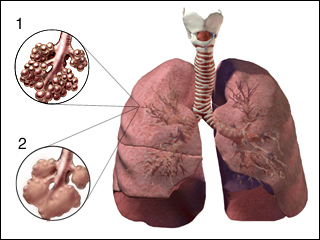The Three Major Symptoms Of Emphysema
There are many lung diseases nowadays, and emphysema is simply one of them. It is a well established that if the lung is to perform its functions properly, the tissue that make it up have to maintain a certain physical shape. Oxygenation of the blood takes place in the lungs, and that is also where gases interchange.

When the lungs do not function normally, it could mean that the tissue that maintains its shape is malfunctioning or even destroyed. This leads to manifestation of several symptoms that we will be looking at shortly. Be warned, however, that these symptoms will show themselves one at a time, not all in one burst. Rather, they tend to come about progressively: such that a patient starts with one of these symptoms, before advancing to the next one and then to the next one after that.
Breathlessness is symptomatic of emphysema, so expect this to be the first sign that a person is most likely to be suffering this exact lung disease. Since the lung tissue will be experiencing a gradual destruction, that means this disease will also take quite a while before it eventually turns into a full-blown lung disease. At first, it would take a major exertion before breathlessness sets in so it wouldn't be associated immediately with the disease. If left unchecked, the disease would then have the patient experience bouts of breathlessness even when he does not exert any effort at all. The patient would also be feeling bouts of breathlessness even when in the middle of sitting down. That is what will definitely happen if nothing is done to solve the problem. You can probably dismiss the early stages of the symptom as something that is just normal. The symptoms could then become distressing if left too long. That is when the person decides to get proper medical treatment for their condition.
Yet another symptom you should watch out for since it could mean emphysema is chest expansion. This is the obvious result of the breathing difficulties associated with the disease. Because of this difficulty, the chest would have to expand so much in order to make up for the shortage of air. You can try to confirm if this symptom is really what you are experiencing. All you have to do is measure the antero-posterior diameter of your chest.
If the patient notices his skin adapting a bluish tinge, he is observing one of the major symptoms of emphysema. It is not only emphysema that manifests this symptom. Lung diseases that involve lack of blood oxygenation will be showing this symptom. This particular symptom is referred to as cyanosis, and like the other symptoms of the disease we are focusing on, it tends to come about gradually. In the early stages of the disease, the cyanosis may not be noticeable, but a point soon comes (especially if no interventions are put in place) when the change in skin color can't be ignored.
Recommended Link:
Treatments Of Emphysema
